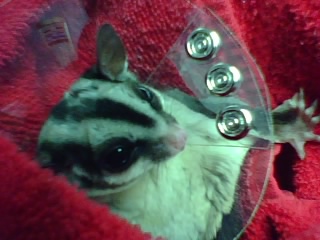Fecal examination is an important part of routine health care for sugar gliders, as sugar gliders, especially those bred in mills or mass breeding situations, are at very high risk for carrying parasites and for active parasite infection.
Many owners trust their vet to provide the best quality of care, so they do not question what test(s) their gliders are having done or what each test is for. In many cases, only one test is run on feces.
The following are fecal exams which may be run on your glider's feces:
Fecal Smear - often called a "direct fecal" or "fecal- direct" - In cases where only a very small amount of feces can be collected or remains viable, this might be the only test that can be run. The fecal smear consists of smearing (hence the name) a small amount of feces onto a slide, adding a bit of saline or other solution (depending on what you are looking for) and then examining it under a microscope.
The fecal smear will allow the vet to see cysts or eggs that do not float. It also useful for seeing protozoa which are active at the time of the exam.
Fecal Flotation - Also called a "float" or "fecalyzer test"
A fecal flotation test is normally used to detect the eggs (and sometimes the larvae) of various parasitic worm species that are shed into feces as well as the oocysts shed into the droppings by various, replicating protozoan organisms.
The fecal float consists of gathering the feces into a container, mixing it well with a solution (fecalyzer, fecasol, etc) and allowing it to "set up." The mixed solution is then placed onto a slide and examined under a microscope.
Fecal Flotation can detect a number of different parasites, including (but not limited to) roundworm, hookworm, tapeworm, Strongyloides, toxoplasma, giardia and coccidia.
Fecal flotation will likely NOT detect parasites that do not dwell in the gastrointestinal tract, biliary ducts or lungs (where the eggs may be coughed up and swallowed and appear in the feces) , parasites whose eggs are too heavy to float (e.g. trematode eggs) or who exist solely as motile, swimming protozoans (i.e. do not produce a resistant, flotable cyst), parasites who reproduce by means of live larvae or quick-hatching eggs (live young, not flotable eggs) , parasites who exert their tissue-damaging effects whilst still in a larval or intermediate (juvenile) form, tapeworms that shed whole segments into the feces instead of individual eggs, and fragile parasites that are easily destroyed by most fecal flotation mediums.
SNAP Giardia Test - also called SNAP test
The SNAP test for giardia detects soluble Giardia antigens - this means that it tests for an antigen secreted by giardia rather than for the giardia itself. It is a very effective test for confirming or eliminating a diagnosis of giardia. It will detect the presence of giardia even when a fecal flotation or smear do not.
The SNAP test will test for giardia ONLY. It will NOT tell you whether or not any other parasite is present.
Fecal Culture -
The fecal culture must be conducted in a lab.
The culture consists of collecting the feces and setting it up for bacterial growth. It will take 2-5 days to complete the test. This test will tell you which bacteria, if any, are present in the feces. The fecal culture is effective in diagnosing bacterial infections of the gastrointestinal tract, but will not test for any parasites.
******************************
Note:
If an animal has been treated with anti-diarrhea preparations containing bismuth or kaolin, mineral oil, oral contrast material (barium) for radiology (all of these materials float) or antibiotics, then parasites may be difficult or impossible to find. Therefore, the fecal exam should be conducted or repeated 5-10 days after treatment withdrawal.
